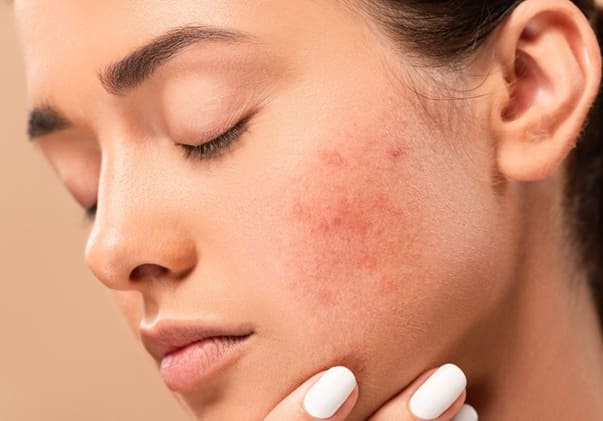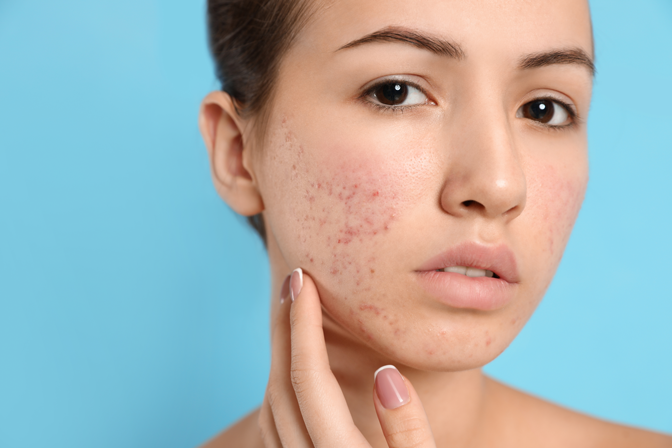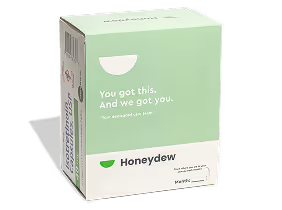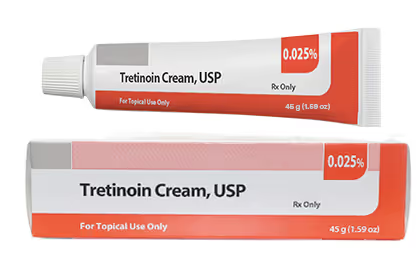Acne affects millions of people, and the search for effective treatments can feel endless. Among the many options available, benzoyl peroxide stands out as one of the most proven and accessible treatments for acne. Whether you're dealing with occasional breakouts or persistent blemishes, understanding how to use benzoyl peroxide properly can make a significant difference in achieving clearer skin.
At Honeydew, we believe in evidence-based treatments that work. While benzoyl peroxide is an excellent starting point for many people, we also understand that acne is highly individual. If you find that over-the-counter options aren't delivering the results you want, our providers can create a personalized acne treatment plan with prescription-strength medications tailored specifically to your skin.
What Is Benzoyl Peroxide and How Does It Work?
Benzoyl peroxide is a topical medication that has been used to treat acne for decades. Its effectiveness comes from its ability to target multiple factors that contribute to acne development.
The primary mechanism of benzoyl peroxide is its potent antibacterial action. It kills Cutibacterium acnes (P. acnes), the bacteria that thrive in clogged pores and contribute to inflammation. Unlike topical antibiotics, bacteria do not develop resistance to benzoyl peroxide, making it a reliable long-term option.
Benzoyl peroxide also acts as a mild exfoliant. It helps clear dead skin cells and excess oil from pores, preventing the formation of comedones (blackheads and whiteheads). This dual action—antibacterial and exfoliating—makes benzoyl peroxide particularly effective for inflammatory acne, including pustules and papules.
Choosing the Right Benzoyl Peroxide Strength
Benzoyl peroxide products are available in various strengths, typically ranging from 2.5% to 10%. Many people assume that higher concentrations are more effective, but research tells a different story.
Studies show that lower strength benzoyl peroxide products are as effective as higher strength preparations. A 2.5% benzoyl peroxide product can deliver the same acne-fighting results as a 5% or 10% formulation, but with significantly less irritation.
If you're not sure which acne product to buy, start with one that contains benzoyl peroxide. It is recommended to consider starting with a lower strength (2.5%) water-based benzoyl peroxide product to lower the risk of side effects. This approach allows your skin to adjust to the ingredient while still providing effective treatment.
Water-based formulations are generally less irritating than alcohol-based products, making them a better choice for those with sensitive skin or those new to benzoyl peroxide.
How to Use Benzoyl Peroxide for Acne
Proper application of benzoyl peroxide is key to maximizing its benefits while minimizing potential irritation.
Start Slowly
When introducing benzoyl peroxide into your routine, start with once-daily application. Many people apply it in the evening after cleansing their face. If your skin tolerates it well after a few weeks, you can increase to twice-daily use if needed.
Begin with a small amount—a pea-sized amount is typically sufficient for the entire face. Apply it to clean, dry skin, focusing on acne-prone areas. Avoid applying benzoyl peroxide immediately after washing if you have sensitive skin; waiting 20-30 minutes can help reduce irritation.
Be Consistent
Like most acne treatments, benzoyl peroxide requires consistency. It can take several weeks to see noticeable improvement, and full results may not appear for two to three months. Patience and regular use are essential.
Use With a Moisturizer
Benzoyl peroxide can be drying, especially when you first start using it. Applying a gentle, non-comedogenic moisturizer after the benzoyl peroxide has been absorbed can help maintain your skin's moisture barrier and reduce dryness and peeling.
Apply Sunscreen Daily
While benzoyl peroxide itself does not increase sun sensitivity as dramatically as some other acne treatments, protecting your skin from sun damage is always important. Use a broad-spectrum sunscreen with at least SPF 50 every morning.
Benzoyl Peroxide Product Types
Benzoyl peroxide is available in several formulations, each suited to different preferences and skin types.
Cleansers and Washes
Benzoyl peroxide cleansers are an excellent option for those who want to incorporate the ingredient into their routine without leaving it on the skin all day. These products are typically used twice daily and rinsed off after a brief contact time (usually 1-2 minutes).
Washes with 2.5% to 4% benzoyl peroxide are often recommended as part of a comprehensive acne treatment plan, even when using other topical or oral medications.
Leave-On Gels and Creams
Leave-on benzoyl peroxide products provide longer contact with the skin, which can be more effective for some people. These are applied after cleansing and left on throughout the day or night.
Gels tend to be lighter and may be preferred by those with oily skin, while creams can be more moisturizing and better suited for those with dry or sensitive skin.
Spot Treatments
Benzoyl peroxide spot treatments are designed to be applied directly to individual blemishes. These products often contain higher concentrations (5-10%) and can be useful for targeting specific areas rather than treating the entire face.
Combining Benzoyl Peroxide With Other Treatments
Benzoyl peroxide works well as a standalone treatment for mild acne, but it can also be combined with other ingredients for enhanced results.
With Topical Retinoids
Combining benzoyl peroxide with a topical retinoid like tretinoin or adapalene can be highly effective. The retinoid normalizes skin cell turnover to prevent clogged pores, while benzoyl peroxide kills bacteria and reduces inflammation.
However, using both ingredients can increase the risk of irritation. To minimize this, apply them at different times of day—benzoyl peroxide in the morning and the retinoid at night—or use them on alternating days until your skin adjusts.
With Topical Antibiotics
Pairing benzoyl peroxide with a topical antibiotic like clindamycin can enhance antibacterial action while preventing antibiotic resistance. Many dermatologists prescribe combination products that contain both ingredients in a single formulation.
With Oral Medications
For moderate to severe acne, benzoyl peroxide is often used alongside oral medications such as doxycycline or spironolactone. The topical treatment addresses surface bacteria and clogged pores, while the oral medication works systemically to reduce inflammation or regulate hormones.
When Benzoyl Peroxide Isn't Enough
Benzoyl peroxide is an excellent first-line treatment for mild acne, but it has limitations. If you've been using benzoyl peroxide consistently for several months without significant improvement, or if your acne is moderate to severe, it may be time to explore prescription options.
At Honeydew, we understand that persistent acne can be frustrating. If over-the-counter treatments haven't worked for you, our providers can prescribe more powerful medications that target acne from multiple angles. This includes prescription-strength topical treatments, oral medications, and innovative options like low-dose Accutane.
For any type of acne, especially persistent acne, oral isotretinoin (found in brands like Accutane and Absorica) can provide lasting results. Our providers specialize in personalized dosing strategies that maximize effectiveness while minimizing side effects, and we manage your entire treatment online with regular check-ins.
Common Concerns About Benzoyl Peroxide
Bleaching Fabrics
One practical consideration with benzoyl peroxide is that it can bleach fabrics, including towels, pillowcases, and clothing. To avoid this, use white towels and pillowcases, or allow the product to fully absorb and dry before contact with fabrics.
Initial Irritation
Some people experience redness, dryness, or peeling when they first start using benzoyl peroxide. These effects are usually temporary and decrease with continued use. Starting with a lower concentration and building up gradually can help minimize irritation.
Not Suitable for All Acne Types
Benzoyl peroxide works best for inflammatory acne (pustules and papules) and mild comedonal acne. It is less effective for deep, cystic acne or acne driven primarily by hormonal factors. In these cases, prescription treatments are typically necessary.
Building a Complete Acne Treatment Routine
Benzoyl peroxide is most effective when used as part of a comprehensive skincare routine. A basic routine for acne-prone skin should include:
- A gentle, non-comedogenic cleanser (or a benzoyl peroxide wash)
- A treatment product containing benzoyl peroxide or other active ingredients
- A lightweight, oil-free moisturizer
- A broad-spectrum sunscreen during the day
Avoid using harsh scrubs, astringent toners, or multiple drying products at once, as these can compromise your skin barrier and worsen irritation.
Honeydew: Your Path to Clearer Skin
Benzoyl peroxide is a powerful, proven ingredient that can make a real difference in managing acne. By starting with a lower strength, using it consistently, and combining it with a gentle skincare routine, many people see significant improvement in their skin.
However, if you've been using benzoyl peroxide for several months without the results you want, or if your acne is more severe, don't lose hope. Effective prescription treatments are available, and at Honeydew, we're here to help you find the right solution. Our providers can manage, adjust, and recommend treatments completely online to ensure you get the clear, healthy skin you deserve. Learn more about how we can support your journey to clearer skin at Honeydew.























